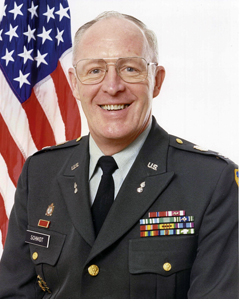Colonel
Werner G. Schmidt Jr.
 Born April 17, 1940, in
Philadelphia, Werner Schmidt graduated from La Salle University in 1963. His first tour of duty was with B
Battery, 1 Battalion, 20th Artillery in the 4th Infantry Division at Fort Lewis, Washington. He next served, from
1965 to 1966, as Section Commander, then Commander of the 6th Missile Detachment, 570th Artillery Group, Trier,
Germany. From 1966 to 1967, Schmidt served as Assistant S-3, 514th Artillery Group in Moenchengladbach, Germany,
and then took command of the 517th Heavy Equipment Maintenance Company at Schwetzingen, Germany. In 1968, he went
to Vietnam, serving as Supply Management Officer and then Branch Chief at the US Army Inventory Control Center,
Long Binh, where he implemented the inventory-in-motion program for artillery gun tubes and other critical items.
Schmidt next served, from 1970 to 1974, as a Combat Development Staff Officer at Combat Development Command and
then at Training and Doctrine Command, Fort Monroe, Virginia, preparing the first product-improvement document for
the M60A1 Tank.
Born April 17, 1940, in
Philadelphia, Werner Schmidt graduated from La Salle University in 1963. His first tour of duty was with B
Battery, 1 Battalion, 20th Artillery in the 4th Infantry Division at Fort Lewis, Washington. He next served, from
1965 to 1966, as Section Commander, then Commander of the 6th Missile Detachment, 570th Artillery Group, Trier,
Germany. From 1966 to 1967, Schmidt served as Assistant S-3, 514th Artillery Group in Moenchengladbach, Germany,
and then took command of the 517th Heavy Equipment Maintenance Company at Schwetzingen, Germany. In 1968, he went
to Vietnam, serving as Supply Management Officer and then Branch Chief at the US Army Inventory Control Center,
Long Binh, where he implemented the inventory-in-motion program for artillery gun tubes and other critical items.
Schmidt next served, from 1970 to 1974, as a Combat Development Staff Officer at Combat Development Command and
then at Training and Doctrine Command, Fort Monroe, Virginia, preparing the first product-improvement document for
the M60A1 Tank.
From 1974 to 1975, he served as Chief of Inventory Branch, Defense Attaché Office Support Element in Vientiane, Laos, where he developed an inventory management system for the Royal Laotian Army. He played a key role in evacuating military dependents and civilians in the chaotic period following the takeover by the Communist Pathet Lao. Returning to the United States, Schmidt served as Executive Officer of the 1st Infantry Division's 701st Maintenance Battalion and then as division Assistant G-4. He orchestrated an on-schedule division deployment to a REFORGER (Return of Forces to Germany) exercise despite a record Kansas blizzard. In 1980, Schmidt assumed command of the 701st Maintenance Battalion, maintaining a 95 percent or higher division readiness rate while reducing the maintenance backlog over 30 percent.
He next served, from 1983 to 1986, at the Department of the Army, Office of the Deputy Chief of Staff for Logistics (DCSLOG) in Washington. He was Deputy Director, then Director of the DCSLOG Battle Staff, a select group of staff officers who managed force modernization and materiel fielding. Schmidt was next assigned to Aberdeen Proving Ground as Chief of Staff, Office of the Chief of Ordnance, from 1986 to 1988. Responsible for personnel proponency, he developed an ROTC recruiting program that enhanced the quality of cadets accessed to the Ordnance Corps.
Schmidt's next assignment, from 1988 to 1990, was as Commander of the 54th Area Support Group and the Rheinberg Military Community Activity in Germany. He was responsible for the morale and welfare of 7,000 personnel spread over 35,000 square miles and for maintaining substantial war reserve stocks. He next served, from 1990 to 1992, as Chief of Staff, Combined Arms Support Command (CASCOM), at Fort Lee, Virginia, leading the staff through a tumultuous period of reorganization. In his last assignment, he served as Fort Lee's Garrison Commander, winning first place in the Medium category of the Training and Doctrine Command's Communities of Excellence competition. COL Schmidt retired in 1993 after 30 years of dedicated service to the Army and the Ordnance Corps.